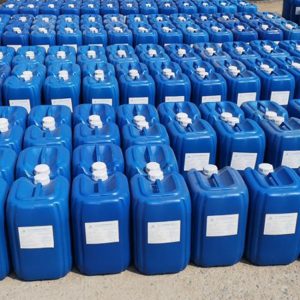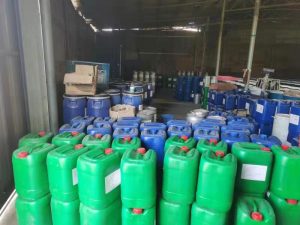Investigation of the matting effect of aromatic amines and zinc ion complexes in powder coatings
Disclaimer: Part of the information from the network, reproduced for the purpose of conveying more information and sharing, and does not mean to endorse its views or confirm its authenticity, and does not constitute other recommendations. It only provides a platform for communication and is not responsible for its copyright. If infringement is involved, please contact us for timely modification or deletion.

Abstract: Zinc 2-mercaptobenzothiazole (ZMBT) is widely used in the matting system of powder coatings. In this paper, we put forward the following hypothesis for its matting structural model: the structural model of “epoxy resin curing agent + zinc ion” can be used as a matting agent for epoxy resin powder coatings, and based on the hypothesis, we have synthesized the structural models of two aromatic amines, 4,4-diaminobenzene methane (DDM), 4,4-diaminodiphenyl sulfone (DDS) and zinc chloride. Based on this assumption, two aromatic amines, 4,4-diaminobenzene methane (DDM) and 4,4-diaminodiphenylsulfone (DDS), were synthesized as complexes with zinc chloride, and the matting effects of the two aromatic amines and the corresponding zinc salts were compared with those of ZMBT. The results showed that both complexes had similar matting effects to ZMBT in powder coatings, but lower film gloss could not be obtained by compounding with other matting substances.

1 Preface
Zinc 2-mercaptobenzothiazole (ZMBT) as the basis for the establishment of powder coating matting system is currently the most widely used; the system matting effect is stable, the gloss can be adjustable, and at the same time, has excellent anti-yellowing performance, but the storage stability of powder coatings is not good. ZMBT is made of 2-mercaptobenzothiazole (MBT) complexed with zinc ions under alkaline conditions [1], in which MBT can be epoxy-based and can have ring-opening addition reactions [1]. ring-opening addition reaction [2], which can be used as a curing agent or curing accelerator for epoxy resins. In order to investigate the matting mechanism of aromatic amine zinc salts on powder coatings, we put forward the following hypothesis: is it possible to achieve the matting effect when the curing agent of epoxy resin is combined with zinc ions?
Based on the above hypothesis, we selected two aromatic amine epoxy resin curing agents: 4,4-diaminobenzylmethane (DDM) and 4,4-diaminodiphenylsulfone (DDS), of which DDM is more reactive and can directly cure E-12 epoxy resin for powder coatings, while DDS is less reactive and can be reacted with liquid epoxy, and both of the aromatic amines can be effectively complexed with zinc ions [3]. Therefore, in this paper, we designed and synthesized the complexes of the above two epoxy resin curing agents with zinc ions (as shown in Fig. 1), and compared the matting effects of the two aromatic amine curing agents as well as the corresponding zinc salt complexes with those of the conventional zinc 2-mercaptobenzothiazole system.
2 Experimental section

2.1 Raw materials
Zinc chloride (analytically pure), ethanol (95%), DDM, DDS, ZMBT, zinc dimethyldithiocarbamate (ZDEC, melting point 250°C), epoxy resin E-12, Xinzhongfa 50/50 polyester P5086, Anhui Excalibur 50/50 polyester SJ3#B, Yulin polyester YL5050, aluminum salts, barium matting, lightening agent, leveling agent, benzoin and carbon black are all industrial grade. etc. are all industrial grade.
2.2 Experimental equipment
Three-necked flask (500mL), oil bath with magnetic stirring, filter extraction device, twin-screw extruder, high-pressure electrostatic spraying equipment, constant temperature blast oven, coating film thickness meter, gloss meter, coating film impactor, metallurgical microscope and so on.
2.3 DDM/zinc ion complex preparation
The synthesis process of aromatic amine/zinc salt complex was as follows [4], 19.8 g DDM was added to the flask with 100 mL of ethanol and stirred in an oil bath at 60°C until complete dissolution, 14 g of zinc chloride was added to the solution, a large number of solids were precipitated immediately, and the reaction was continued to be stirred for 30 min, then cooled, filtered, washed, and dried in oven at 50°C for 2 h to obtain 30 g of yellowish powdered solids, i.e., DDM/ Zn2+ complex, yield 88.7%, melting point 320 ℃.
2.4 Preparation of DDS/Zn ion complexes
Add 24.8 g of DDS and 100 mL of ethanol in a flask, stir in an oil bath at 60 ℃ until completely dissolved, add 14 g of zinc chloride to the solution, stir the reaction for 2 h, then cool, filter, wash, and dry in an oven at 50 ℃ for 2 h to obtain 32 g of white powdery solid, i.e., DDS/Zn2+ complex, with a yield of 82.3% and a melting point of 315 ℃.
2.5 Powder coating and coating preparation
The experimental resin, curing agent and filler were mixed well according to the formula, and then incorporated into the extrusion → cooling and pressing → crushing → sieving → powder coating, and then electrostatically sprayed on the tinplate, with the thickness of 70~90 μm, and then cured at 200 ℃/12 min to obtain the coating film.
3 Results and Discussion
3.1 Curing epoxy resin matting
According to the data in Table 1, the four zinc ion complexes can cure epoxy resin well, and the impact performance of the coating film is good; as can be seen, the curing of ZMBT, DDM/Zn2+, DDS/Zn2+ produces flat matting surfaces, and the microscopic surface morphology is very close to the hypothesis.
ZDEC is not an epoxy resin curing agent and zinc ions, not in line with the “epoxy curing agent + zinc ions” structural model, the reason why the epoxy resin can be cured because of the zinc ions in the ZDEC; zinc chloride is a kind of Lewis acid, which can promote the epoxy ring-opening reaction, but the reaction speed is too fast to be used alone [3], the ligands in ZDEC change the surface of the cured epoxy resin, the surface appearance of the microstructure is close, in line with the hypothesis. The ligand in ZDEC changes the reactivity of zinc ion so that ZDEC can cure epoxy resin; the cause of wrinkles on the surface of the coating film may be the curing reaction speed is too fast; and the matting effect is due to the wrinkle effect of the coating film.
ZMBT, DDM/Zn2+, DDS/Zn2+ cured epoxy resin gelation time difference is large, which just with the three ligands MBT, DDM, DDS and epoxy resin reactivity order coincides with; DDS reactivity is the weakest, so the DDS/Zn2+ cured epoxy gelation time is the longest; MBT reactivity is the strongest, the ZMBT gelation time is the shortest.
3.2 Matting of mixed systems
According to the data in Table 2, ZMBT, DDM/Zn2+, and DDS/Zn2+ can realize effective matting in the mixed system, which can reduce the gloss by about 10% and the surface is flat; it can be intuitively seen from the microscope photographs of Fig. 3; the surface morphology of the blank group (a) is relatively flat, while DDM (b), ZMBT (c), and DDS (d) can change the microscopic roughness of the surface of the coating film DDM(b), ZMBT(c), and DDS(d) can change the micro-roughness of the coating surface, creating denser and deeper “holes” and thus matting the surface. Because ZDEC does not conform to the “epoxy curing agent + zinc ion” structure model, so it can not produce matting effect in the hybrid system;
Because zinc ion compounds can be regarded as synergistic curing agents of epoxy resin, and their melting points are higher, thus prolonging the curing time of epoxy resin; therefore, the gelation time of ZMBT, DDM/Zn2+, and DDS/Zn2+ added into the mixed system formulation is higher than that of their corresponding blank groups. The effect of ZMBT on the curing time is the weakest, while the effect of DDS/Zn2+ on the curing time is the most obvious, which extends from 225 s to 300 s in the blank group; the difference in the gelation time is caused by the difference in the reaction rates of MBT, DDM, and DDS with epoxy groups, which may ultimately affect the extinction performance of the zinc ion compounds in the compound.
Due to the weak reactivity of DDM/Zn2+ and DDS/Zn2+ compared with ZMBT, the gelation time of the powder coatings was long, only ZMBT compounded with aluminum salt could produce obvious gain matting effect, and the gloss of DDM/Zn2+ compounded with aluminum salt was elevated instead.
4 Conclusion
In this paper, the hypothesis that the “epoxy curing agent + zinc ions” model can eliminate light is verified at three levels. (i) cured epoxy resin matting; (ii) mixed system matting; (iii) compounding gain matting; in the matting effect of 4,4-diaminobenzyl methane (DDM), 4,4-diaminodiphenylsulfone (DDS) does not meet the third level of the requirements of the ligand reactivity is different, MBT is obviously more “suitable” for combining with zinc ions. This paper verifies the feasibility of the “epoxy curing agent + zinc ion” structure model for matting, which helps to understand the matting mechanism of ZMBT in powder coatings.